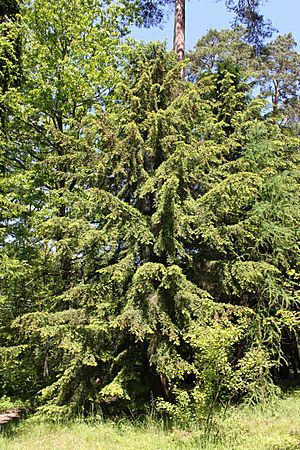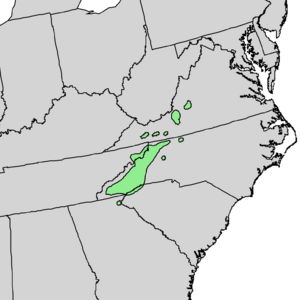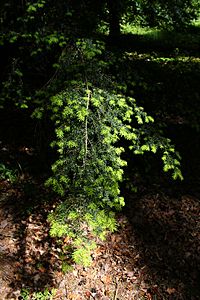Carolina hemlock facts for kids
Quick facts for kids Carolina hemlock |
|
|---|---|
 |
|
| Habit, Arboretum in Rogów, Poland | |
| Conservation status | |
| Scientific classification | |
| Genus: |
Tsuga
|
| Species: |
caroliniana
|
 |
|
The Carolina hemlock (Tsuga caroliniana) is a special evergreen tree. It is found in the Appalachian Mountains in the southeastern United States. You can see it in states like Virginia, North Carolina, Georgia, South Carolina, and Tennessee. This tree likes to grow on rocky mountain slopes. It usually lives at high places, between 700 and 1200 meters (about 2,300 to 3,900 feet) above sea level. It grows best in cool places with some shade and damp, well-drained soil.
Contents
What Does the Carolina Hemlock Look Like?
The Carolina hemlock is a tall evergreen tree. This means it keeps its leaves all year round. It can grow up to 30 meters (about 100 feet) tall. Sometimes, it can even reach 34 meters (about 112 feet). Its trunk can be as wide as 110 centimeters (about 43 inches).
Tree Shape and Bark
The top part of the tree, called the crown, is shaped like a pyramid. It is very dense and can spread out up to 8 meters (about 26 feet) wide. The bark is thick and reddish-brown. As the tree gets older, the bark gets cracks and scaly ridges. The branches are strong and usually grow straight out. Some branches might droop a little.
Leaves and Cones
The small branches, called shoots, are reddish-brown or orange-brown. They have fine hairs on them. The leaves are like needles, about 5 to 20 millimeters long. They are flat and do not get narrower at the end. Their tips are rounded or slightly notched. These leaves grow out in all directions from the twigs. If you crush them, they smell like tangerines! The top side of the leaves is shiny dark green. The underside is paler and has two white lines called stomatal bands. These bands help the tree breathe.
The cones are small, about 2 to 4 centimeters (about 0.8 to 1.6 inches) long. They start out green. After about 6 to 7 months, they turn light to mid-brown. When the cones open fully, their scales stick out at a right angle. Some scales might even bend backward from the center.
Threats to the Carolina Hemlock
A tiny insect called the hemlock woolly adelgid is a big danger to the Carolina hemlock. This insect came to the United States from Asia in 1924. It also harms the Eastern hemlock, which is a close relative of the Carolina hemlock. These insects can seriously damage or even kill the trees.
Uses of the Carolina Hemlock
The Carolina hemlock is quite rare. Because of this, it is not often used for wood or timber. Instead, people mostly use it as an ornamental tree. This means it is planted in gardens and parks for its beauty.
Carolina Hemlock in Landscaping
The Carolina hemlock looks a lot like the eastern hemlock. However, there is an important difference. The Carolina hemlock has a deep taproot. This is a single, large root that grows straight down. The eastern hemlock, on the other hand, has many shallow roots that spread out. Because of its deep taproot, it is easier to grow other plants and shrubs around a Carolina hemlock. Its roots do not get in the way as much.
See also
 In Spanish: Tsuga caroliniana para niños
In Spanish: Tsuga caroliniana para niños



